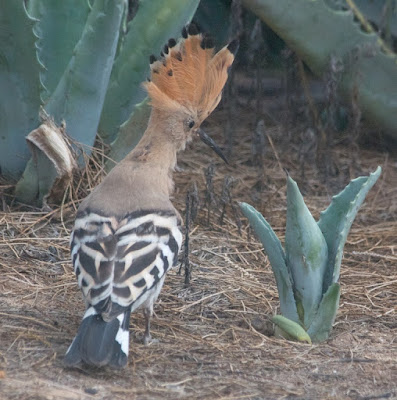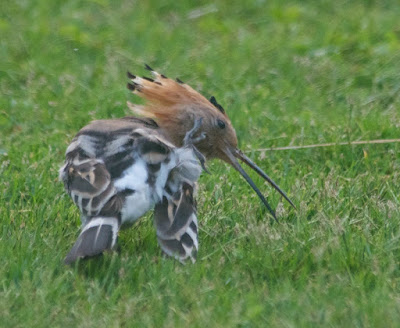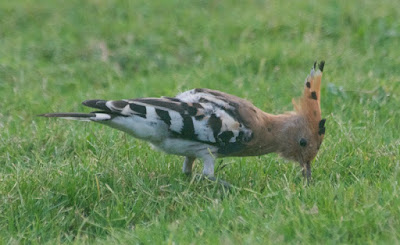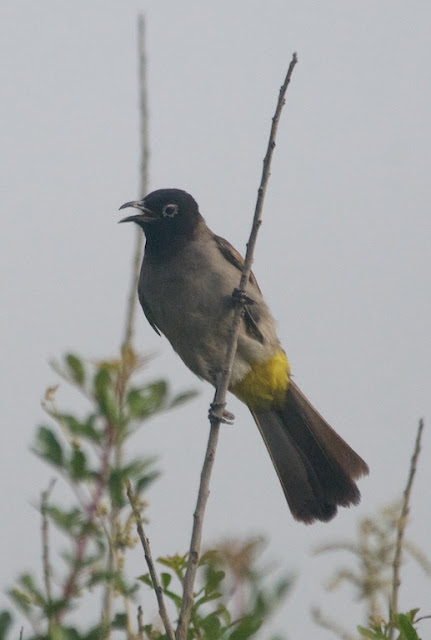On my last day in Israel (September 7, 2015), I only had time for a brief stroll around my hotel before heading to the airport. Fortunately, my hotel sat on the Mediterranean amid an extensive patch of coastal scrub, and so my stroll proved to be surprisingly productive. Say what you like about Tel Aviv, it’s a most enjoyable place to go birding.
Hoopoes are abundant in Israel. In fact, hoopoes in general (whether one species, two, three or four, depending on which taxonomist you are talking to) are among the most wide-ranging birds in the Old World. Dismissing them as commonplaces, though, is all but impossible, especially for a North American who never gets to see such a creature back home (that is, except for the one Bethel, Alaska, hunter who collected - on USFWS instructions - the only hoopoe ever found in North America, back in 1975).
Hoopoes are extraordinary-looking birds even when they aren't raising their flamboyant crests. When they are, you can't look at much else. This is perhaps the most spectacular crest of any bird, but until very recently we were not sure what the bird used it for. A study published only in 2017 suggests that hoopoes raise their crests for multiple reasons, depending on whether they are confronting a predator, a rival or a potential mate. Or, perhaps, an intrusive birdwatcher.
The long bill is easier to explain. It is, as the Handbook of the Birds of the World puts it, "adapted for sensing and extracting mainly the ground-living larvae and pupae of insects". With it, hoopoes dig among grasses, plunge face-deep into the soil, flip over stones, and generally do whatever they can to dine on mole crickets and other burrowing insects. They can deal with everything from tiny grubs to large, hard-shelled beetles (which they batter to bits on a handy branch), or even the odd lizard.
One of the disadvantages of a standard bird guide is that it can swiftly go out of date. A birder in Tel Aviv may look in vain, for example, for the Vinous-breasted Starling (Acridotheres burmannicus), a South-East Asian aviary escapee that has become established in the area since the turn of the current century.
I was particularly delighted to come across a cooperative Rufous-tailed Scrub-Robin (Cercotrichas galactotes), a species I had seen previously - but at a much greater distance - in Qatar.
Many of Israel’s birds are rather plain creatures, matching the pastel browns of the landscape where they live. Not, though, the male Palestine Sunbird (Cinnyris osea).
Compared to some of the brilliant sunbirds of Africa or Eastern Asia this may appear a rather sombre member of the family, but here it is a standout.
Compared to some of the brilliant sunbirds of Africa or Eastern Asia this may appear a rather sombre member of the family, but here it is a standout.
The female, like others of her kind, is a rather dull, if sprightly, creature.
Rounding out this gallery of resident birds is the White-spectacled Bulbul (Pycnonotus xanthopygos).
Rounding out this gallery of resident birds is the White-spectacled Bulbul (Pycnonotus xanthopygos).
You can tell it is a resident here, at least in the breeding season, because there are young bulbuls about.
Israel, though, is famous as a transit point along a major autumn migration route. Common Whitethroats (Sylvia communis) migrating through Israel in autumn are usually members of the two eastern races: S. c. icterops, which both breeds in northern and central Israel and is a common passage migrant from further north in Asia Minor, and S. c. rubicola from the mountains of Central Asia (nominate S. c. communis from western Europe is commoner in spring). This one, with its dull rufous wings and greyish underparts, may be icterops, but a lot of the birds that turn up here seem to be intermediates.
Willow Warblers (Phylloscopus trochilus) are abundant migrants in Israel, particularly in autumn.
Birds weren't the only animals around the hotel. Male Starred or Roughtail Rock Agamas (Stellagama (Laudakia) stellio), in their rich breeding colours, stood sentinel on rocks or brickwork. This is a fairly local species, confined to Asia Minor, Israel, Jordan, the Sinai and neighbouring Saudi Arabia. It is common in Israel, and the ones I saw certainly didn't seem disturbed by a human presence.
I assume that these lizards are females, but they could just as well be males out of breeding colour.
Agamas spend much of their day basking in the sun. When things get a bit too hot, though, there are always crevices available for a shady retreat.
My final images from Israel: the beautiful Sea Daffodil (Pancratium maritimum), proof that even in the harshest of places (even if the beach at Tel Aviv doesn't exactly qualify) flowers can still bloom.






































No comments:
Post a Comment